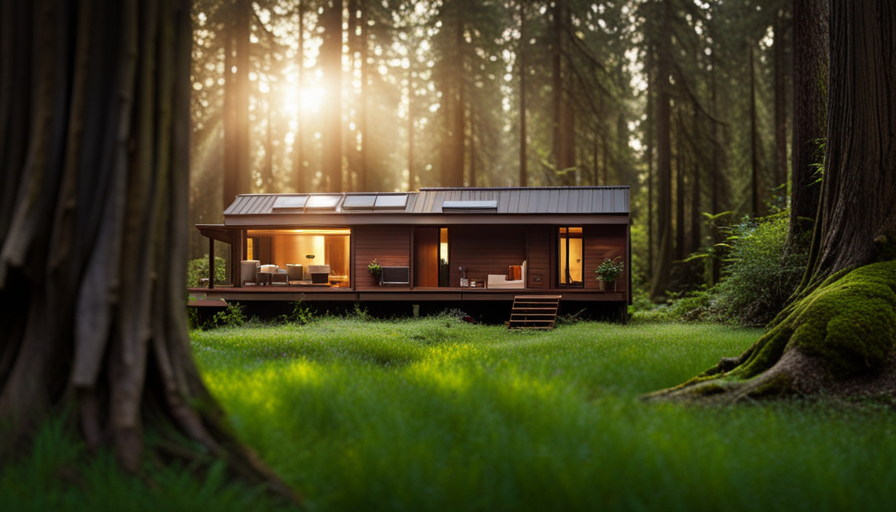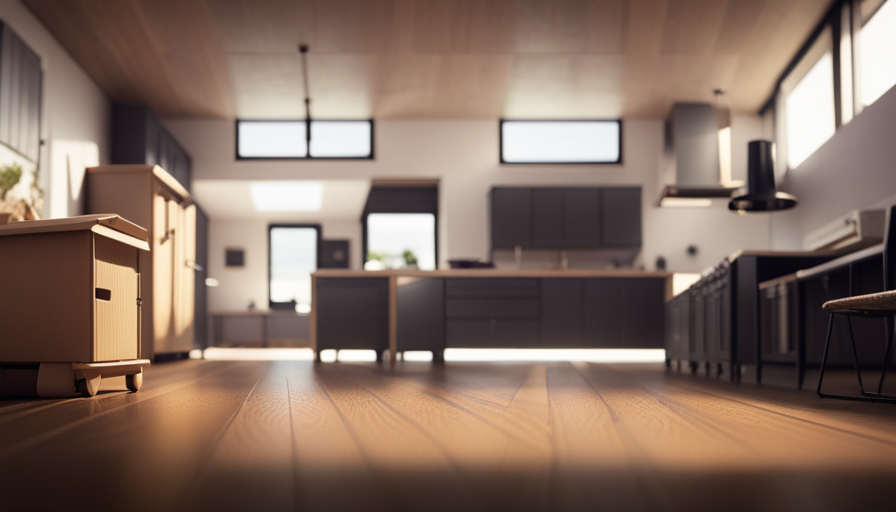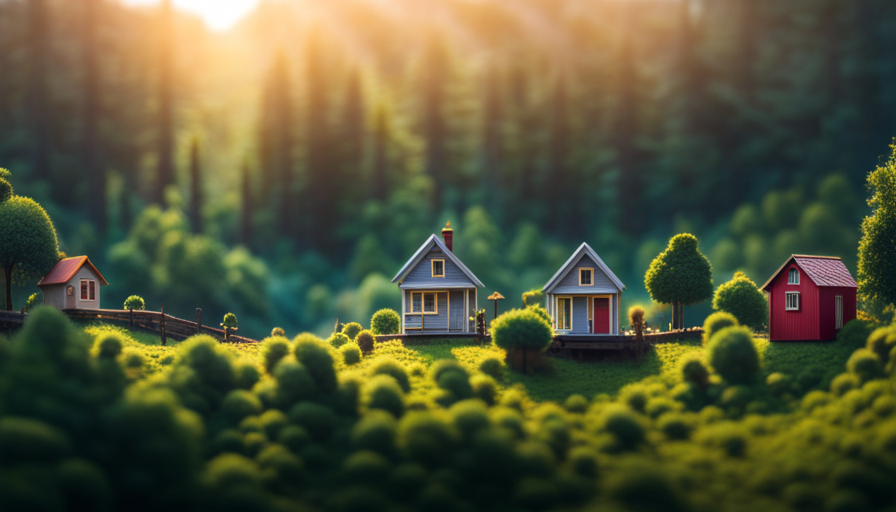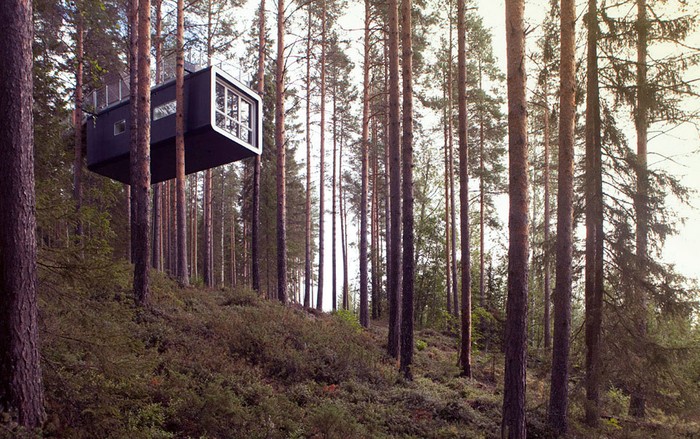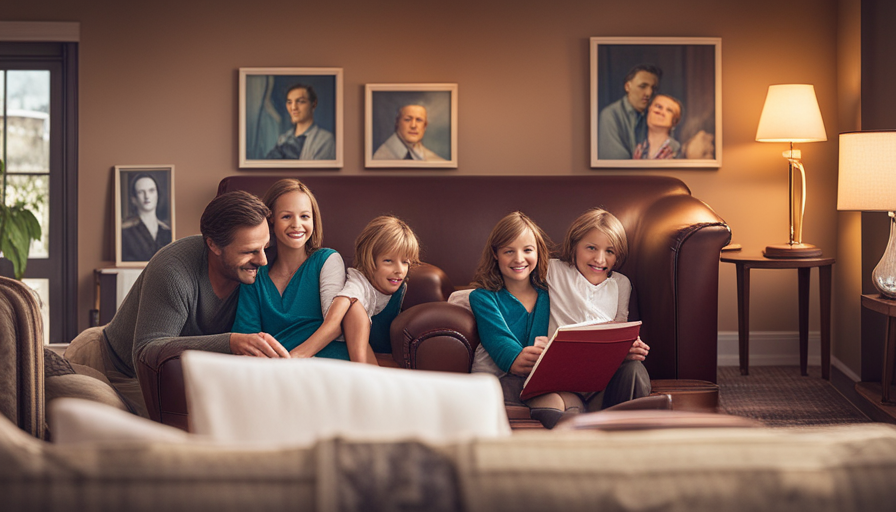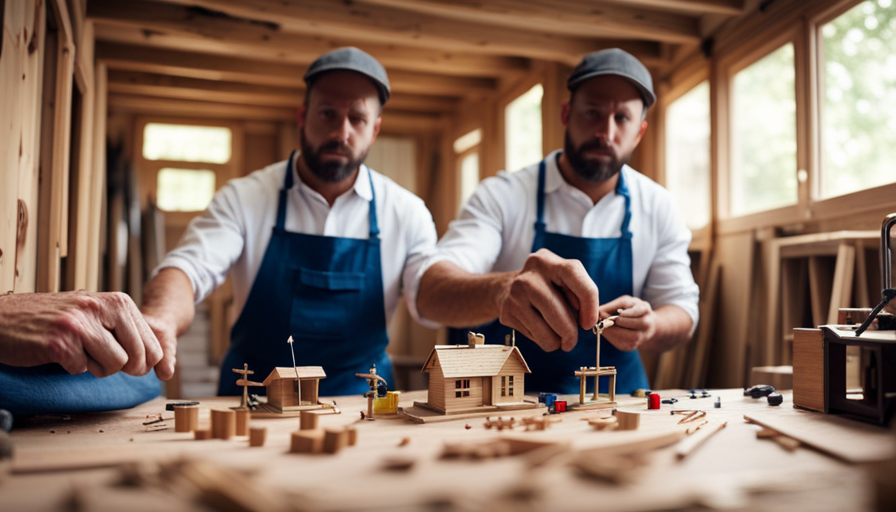Picture this: a grand, expansive estate situated on a small plot of land. Magnificent marble columns, grand staircases, and spacious rooms fit for royalty. It seems like something from a fairy tale, don’t you think? Yet, in the world of tiny homes, these dreams come true, just in a more compact and imaginative way.
Welcome to the realm of tiny houses, where size is not a limitation but a challenge. As a passionate advocate for minimalistic living, I have delved deep into the intricacies of designing and living in these petite dwellings.
In this article, we will unravel the secrets of how big you can actually make a tiny house. From understanding the concept of tiny houses to maximizing space optimization, we will explore the various techniques and strategies that allow these diminutive abodes to pack a powerful punch.
We will also delve into the art of expanding the square footage without compromising on functionality and comfort. So, fasten your seatbelts, because we are about to embark on a journey into the fascinating world of tiny houses, where small is the new big.
Key Takeaways
- Tiny houses prioritize minimalistic living and efficient use of space.
- Incorporating natural elements like large windows and skylights adds aesthetic appeal and openness.
- Space optimization techniques include utilizing vertical space, multi-functional furniture, and storage solutions.
- Loft spaces and outdoor living areas expand the square footage of a tiny house.
Understanding the Concept of Tiny Houses
Are you curious about how small you can go when it comes to tiny houses? Well, the concept of a tiny house is all about designing for functionality while incorporating natural elements.
When it comes to the size of a tiny house, there is no set limit. The key is to maximize every inch of space and make it as efficient as possible. From clever storage solutions to multi-purpose furniture, every aspect of the design is carefully thought out.
Additionally, incorporating natural elements such as large windows and skylights not only adds to the aesthetic appeal but also creates a sense of openness and connection with the surroundings.
By designing for space optimization, we can further enhance the functionality and livability of these compact homes, ensuring that every nook and cranny is put to good use.
Designing for Space Optimization
When designing a tiny house, it’s crucial to maximize every inch of space. One way to achieve this is by utilizing vertical space effectively. By incorporating features like lofted beds or high shelving units, you can make the most of the limited floor area.
Additionally, incorporating multi-functional furniture can help optimize space usage. For example, a sofa that can be converted into a bed or a dining table that can double as a workspace.
Lastly, maximizing storage solutions is essential in a tiny house. Utilizing clever storage options, like built-in cabinets, under-bed drawers, or wall-mounted organizers, can help keep belongings organized and minimize clutter.
Utilizing Vertical Space
To maximize the limited floor area of your tiny house, remember that every inch counts, so make sure to think vertically and utilize the height of the space. Here are four ways you can effectively utilize vertical space in your tiny house:
-
Vertical Gardening: Install wall-mounted planters or use vertical hydroponic systems to grow herbs, vegetables, and flowers. This not only adds greenery to your home but also saves valuable floor space.
-
Space-Saving Furniture: Opt for furniture pieces that can be folded, stacked, or hung on the wall when not in use. Examples include foldable tables, wall-mounted desks, and Murphy beds. These versatile pieces maximize functionality without taking up unnecessary space.
-
Built-in Storage: Install shelves, cabinets, and drawers that reach up to the ceiling. This allows you to store belongings vertically, keeping them organized and easily accessible.
-
Overhead Storage: Utilize the space above doorways and windows to install shelves or cabinets. This often overlooked area can be used to store items that are not frequently used.
By incorporating these vertical space-saving techniques, you can make the most of your tiny house. Transitioning into the subsequent section about incorporating multi-functional furniture, consider how these strategies can be combined with furniture that serves multiple purposes.
Incorporating Multi-functional Furniture
Incorporating multi-functional furniture is key to maximizing space and functionality in your small living area. When designing a tiny house, it’s crucial to choose furniture pieces that serve multiple purposes. This can include items like a sofa that can be transformed into a bed, or a coffee table that doubles as a storage unit.
Multi-functional furniture allows you to make the most of your limited space by eliminating the need for separate pieces. Additionally, space-saving storage solutions are essential in a tiny house. Utilize vertical space with wall-mounted shelves or incorporate hidden storage compartments in furniture pieces.
By cleverly designing your furniture to serve multiple functions and incorporating space-saving storage solutions, you can create a tiny house that feels spacious and organized.
Transitioning into the subsequent section about maximizing storage solutions, it’s important to explore creative ways to optimize every inch of your small living area.
Maximizing Storage Solutions
If you think your itty-bitty living space couldn’t possibly handle any more storage, think again! Maximizing storage ideas and implementing creative space solutions can help you make the most out of your tiny house.
Here are some techniques to consider:
-
Utilize vertical space: Install tall shelves or cabinets that reach the ceiling to maximize storage potential. This allows you to store items that aren’t frequently used in higher areas.
-
Make use of hidden storage: Incorporate furniture pieces with hidden compartments, such as ottomans with storage space underneath or beds with built-in drawers.
-
Optimize wall space: Install hooks, racks, or pegboards on walls to hang frequently used items like pots and pans, tools, or accessories.
By implementing these storage solutions, you can efficiently organize your belongings without sacrificing precious floor space.
Transitioning into the subsequent section about expanding the square footage, let’s explore other ways to make your tiny house feel more spacious.
Expanding the Square Footage
When it comes to expanding the square footage of a tiny house, there are several key points to consider.
First, adding loft spaces can greatly increase the usable area without taking up valuable floor space.
Secondly, incorporating outdoor living areas such as decks or patios can create additional functional areas that extend the living space beyond the confines of the house.
Lastly, utilizing expandable structures, such as slide-out rooms or pop-up additions, allows for flexibility in the size and layout of the tiny house, providing extra room when needed.
These strategies effectively maximize the square footage of a tiny house, making it possible to live comfortably in a compact space.
Adding Loft Spaces
Loft spaces are a great way to maximize the space in your tiny house and create a cozy sleeping area. By adding mezzanine levels, you can effectively utilize the vertical space in your tiny house. This not only gives you an additional sleeping area but also opens up the floor space below for other purposes.
Loft bed designs come in various styles, such as built-in beds with storage underneath or suspended beds that hang from the ceiling. These designs allow you to optimize the available space and create a functional and comfortable sleeping area. Furthermore, loft spaces can be customized to fit your specific needs and preferences. Whether you want a private reading nook or a small office space, incorporating a loft area provides endless possibilities for personalization.
Transitioning into the subsequent section about incorporating outdoor living areas, expanding your tiny house to the outdoors allows you to create additional living space without compromising the cozy interior.
Incorporating Outdoor Living Areas
To fully embrace the charm of your tiny abode, consider bringing the outdoors in by incorporating inviting outdoor living areas, like a cozy patio or a tranquil garden space.
Outdoor cooking is an excellent way to utilize the limited space of a tiny house. Installing a compact grill or a portable outdoor stove can provide you with the opportunity to prepare delicious meals while enjoying the fresh air.
Additionally, garden spaces can add beauty and tranquility to your tiny house. Vertical gardens or hanging planters can maximize the use of vertical space, while potted plants and herbs can be placed strategically to create a vibrant and inviting atmosphere.
By incorporating these outdoor living areas, you can expand the living space of your tiny house and create a seamless transition between indoor and outdoor environments.
Transitioning into the subsequent section about utilizing expandable structures, let’s explore how you can make your tiny house even more versatile.
Utilizing Expandable Structures
Consider using expandable structures to maximize the functionality and versatility of your cozy living space. An expandable tiny house is designed to be easily expanded or contracted, allowing you to adjust the size of your home based on your needs. These modular tiny houses typically consist of prefabricated units that can be added or removed as desired.
To illustrate the potential of expandable structures, consider the following table:
| Pros | Cons | Examples |
|---|---|---|
| Increased living space | Higher cost | Ecocapsule |
| Customizable layout | Complex installation | Living Vehicle |
| Easy transportation | Limited design options | Nestron Cube |
By utilizing expandable structures, you can have the flexibility to adapt your tiny house to different situations, whether it’s accommodating guests or simply creating additional living space. In the next section, we will explore the various ways you can customize your tiny house to make it uniquely yours.
Customizing Your Tiny House
When it comes to customizing my tiny house, there are three key points that I need to consider:
- Choosing the right layout, personalizing the interior design, and incorporating unique features.
First, I need to carefully select a layout that maximizes the use of space and meets my specific needs and preferences.
Next, I’ll focus on personalizing the interior design by selecting colors, materials, and furniture that reflect my style and create a cozy and functional living space.
Finally, I’ll explore incorporating unique features such as hidden storage solutions, multi-functional furniture, or innovative technology to make my tiny house truly one-of-a-kind.
Choosing the Right Layout
Imagine yourself walking through the open layout of a tiny house, where every nook and cranny has been meticulously designed to maximize space and create a cozy atmosphere reminiscent of a well-organized library.
To achieve this, the layout of a tiny house must prioritize certain elements.
-
Maximizing natural light: Large windows, skylights, and strategically placed mirrors can help bring the outdoors in, creating an illusion of a larger space while brightening up the interior.
-
Incorporating efficient heating: In a small space, it’s crucial to choose a heating system that’s both compact and energy-efficient. Options such as radiant floor heating or mini-split systems can effectively warm the entire tiny house without taking up valuable square footage.
-
Optimizing storage: Clever storage solutions are essential in a tiny house. Utilizing multifunctional furniture, such as built-in shelves or storage ottomans, can help maximize the available space while keeping belongings organized and easily accessible.
By carefully considering these factors, you can create a functional and comfortable layout for your tiny house.
Now, let’s explore how to personalize the interior design to truly make it your own.
Personalizing the Interior Design
To truly transform your tiny house into a personalized oasis, let’s dive into the world of interior design and discover how you can infuse your unique style and personality into every corner.
Personalizing color schemes is a great way to set the mood and create a cohesive look throughout your tiny house. Consider using colors that speak to you and reflect your personality. Whether you prefer bold and vibrant hues or soft and soothing tones, the choice is yours.
Additionally, choosing decor that resonates with you is essential. From artwork to furniture, every piece should contribute to the overall aesthetic you want to achieve. Incorporate elements that showcase your interests and passions.
By personalizing the interior design, you can create a space that truly feels like home.
Now, let’s explore how to incorporate unique features into your tiny house.
Incorporating Unique Features
When it comes to personalizing the interior design of a tiny house, there are endless possibilities. From choosing the right color palette to selecting furniture that maximizes space, every decision counts.
However, one way to truly make a tiny house stand out is by incorporating unique features. This can be achieved by using unconventional materials such as reclaimed wood or repurposed shipping containers. Additionally, integrating smart home technology can enhance the functionality and convenience of the space. Imagine controlling the lights, temperature, and security of your tiny house with just a few taps on your smartphone.
It’s important to carefully consider these unique features and how they will fit into the overall design and functionality of the space.
Now, let’s explore how incorporating sustainable practices can further enhance the appeal of a tiny house.
Incorporating Sustainable Practices
Embrace sustainable practices in your tiny house and feel empowered to make a positive impact on the environment. By using sustainable materials and implementing energy efficient design, you can create a tiny house that minimizes its carbon footprint.
When it comes to sustainable materials, opt for those that are renewable, such as bamboo flooring or reclaimed wood for your furniture. Additionally, consider using recycled materials for insulation or countertops.
Energy efficiency can be achieved through proper insulation, double-pane windows, and energy-saving appliances. Install solar panels on the roof to generate renewable energy and reduce reliance on the grid. By incorporating these sustainable practices, you not only save on utility bills but also contribute to a greener future.
Transitioning into the next section, overcoming challenges of tiny house living requires careful planning and creative solutions.
Overcoming Challenges of Tiny House Living
Get ready to face the hurdles of living in a compact abode and discover the art of finding inventive solutions to make the most out of your cozy haven. Overcoming limited space and managing utilities are essential challenges in tiny house living. With limited square footage, it is crucial to utilize every inch of space efficiently. One way to achieve this is by incorporating multifunctional furniture, such as a sofa that can be transformed into a bed or a dining table that can be collapsed when not in use. Additionally, vertical storage solutions, such as wall-mounted shelves and hanging organizers, can help maximize space. Managing utilities in a tiny house requires careful planning. Installing energy-efficient appliances and utilizing renewable energy sources, like solar panels, can help reduce energy consumption. Furthermore, implementing water-saving fixtures and composting toilets can help manage water usage. By overcoming these challenges, you can create a comfortable and sustainable living environment in your tiny house. Transitioning into the subsequent section about exploring different types of tiny houses, it is important to consider the unique features and designs that suit your needs and preferences.
Exploring Different Types of Tiny Houses
When it comes to exploring different types of tiny houses, there are three key points to consider.
First, there are Tiny Houses on Wheels. These homes provide the flexibility to move wherever you desire, allowing you to constantly change your surroundings.
Next, there are Shipping Container Homes. These offer a unique and sustainable living option by utilizing repurposed shipping containers to create functional and compact living spaces.
Lastly, there are Tiny House Communities. These provide a sense of community and support, allowing like-minded individuals to come together and share resources and experiences in a communal living setting.
Tiny Houses on Wheels
Although you might be skeptical at first, you’ll soon realize the immense possibilities you have when it comes to designing and constructing a tiny house on wheels. The freedom and flexibility offered by this type of tiny house are unmatched. One of the main advantages is that tiny houses on wheels are often exempt from many of the strict regulations that govern traditional housing. This allows for more creative and innovative designs without sacrificing safety or comfort. Additionally, the ability to move your tiny house on wheels provides a sense of adventure and the opportunity to change your surroundings whenever you desire. Living in a tiny house on wheels offers the benefits of simplicity, affordability, and sustainability. Transitioning now to shipping container homes, we explore another unique option for those seeking a compact living space.
Shipping Container Homes
Another option for those seeking a compact living space is to consider the unique and cost-effective solution of shipping container homes. These containers, originally designed for transporting goods, have proven to be structurally sound and easily adaptable for residential use. With their sturdy steel construction, shipping containers can withstand extreme weather conditions and can be stacked to create multi-level homes. The interiors can be customized to include all the amenities of a traditional house, such as plumbing, electricity, and insulation.
Additionally, shipping container homes are eco-friendly, as they repurpose existing materials. As we explore the possibilities of alternative housing, shipping container homes provide an exciting and innovative solution.
Transitioning to the subsequent section about ‘tiny house communities,’ we now delve into the social aspects of compact living.
Tiny House Communities
Moving on from shipping container homes, let’s explore the concept of tiny house communities. These communities are designed to accommodate multiple tiny houses in close proximity, fostering a sense of community and shared resources. As an advocate for tiny house living, I find the idea of tiny house communities incredibly appealing. Not only do they provide a supportive environment for like-minded individuals, but they also offer numerous benefits.
One key aspect of tiny house communities is the adherence to specific zoning regulations. These regulations ensure that the communities are properly planned and meet safety standards. Additionally, they often allow for more flexible land use, making it easier for individuals to establish their tiny homes.
The benefits of living in a tiny house community are manifold. Firstly, residents can enjoy a sense of belonging and camaraderie, as they share common spaces and engage in community activities. Secondly, the cost of living is significantly reduced, as shared resources and utilities lower individual expenses. Lastly, these communities promote sustainable living practices and encourage residents to minimize their environmental footprint.
Overall, tiny house communities offer a unique and fulfilling lifestyle, while also addressing the challenges of zoning regulations and fostering a sense of community.
Frequently Asked Questions
How much does it cost to build a tiny house?
The cost to build a tiny house varies depending on various factors such as location, materials used, and amenities included. Cost estimation for a basic tiny house can range from $20,000 to $50,000.
However, financing options are available to make this investment more affordable. Some options include personal loans, RV loans, and crowdfunding. It’s advisable to research and compare different financing options to find the best fit for your needs.
Are there any legal restrictions or regulations for living in a tiny house?
There are several legal challenges and zoning restrictions that one may encounter when living in a tiny house. These regulations vary depending on the location and jurisdiction. Common restrictions include minimum square footage requirements, limitations on the number of occupants, and specific zoning designations for tiny houses.
Additionally, some areas may require a permit or approval process for the construction and placement of a tiny house. It’s crucial to research and adhere to local regulations to avoid potential legal issues.
Can you have pets in a tiny house?
Having pets in a tiny house poses certain challenges. The limited space can make it difficult for pets to roam freely and engage in their natural behaviors. Additionally, the close proximity can result in heightened levels of noise and odors.
However, with proper planning and organization, it’s possible to have pets in a tiny house. Creating designated areas for pets, utilizing vertical space, and implementing efficient storage solutions can help mitigate these challenges and ensure a comfortable living environment for both humans and pets.
What are the maintenance requirements for a tiny house?
Tiny house maintenance involves regular cleaning and repairs to ensure its longevity and functionality. Cleaning includes dusting, vacuuming, and sanitizing surfaces. Repairs may involve fixing plumbing issues, replacing worn-out materials, or addressing structural concerns.
Additionally, energy efficiency is crucial in a tiny house, requiring insulation, proper ventilation, and efficient appliances. Regular inspections of the electrical and plumbing systems are necessary to identify and address any potential issues.
Can you park a tiny house anywhere or do you need to find specific locations for it?
Parking a tiny house can be subject to parking restrictions depending on local regulations. Some areas may have specific zoning laws that dictate where a tiny house can be parked. Additionally, off-grid living, which involves not being connected to public utilities, may require finding specific locations that can support this lifestyle.
It’s important to research and understand the local regulations and requirements before attempting to park a tiny house.
Conclusion
In conclusion, the world of tiny houses is vast and full of possibilities. As I reflect on the concept of expanding the square footage, I can’t help but be reminded of a butterfly emerging from its cocoon.
Just as the butterfly grows and transforms, so too can a tiny house be designed to adapt and accommodate our changing needs. By incorporating sustainable practices and customizing our tiny houses, we can create a space that not only maximizes efficiency but also reflects our unique personalities.
So, let’s spread our wings and embrace the boundless potential of tiny house living.
Hi, I’m Emma. I’m the Editor in Chief of Tiny House 43, a blog all about tiny houses. While tree houses are often associated with childhood, they can be the perfect adult retreat. They offer a cozy space to relax and unwind, surrounded by nature. And since they’re typically built on stilts or raised platforms, they offer stunning views that traditional homes simply can’t match. If you’re looking for a unique and romantic getaway, a tree house tiny house might just be the perfect option.
